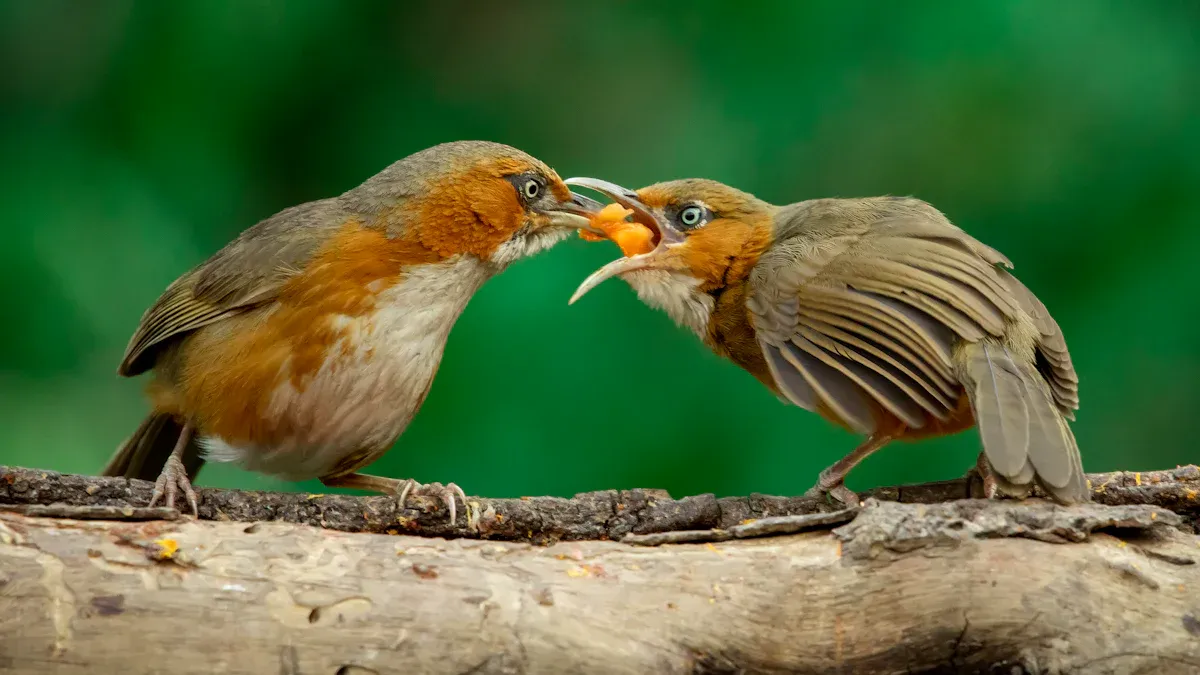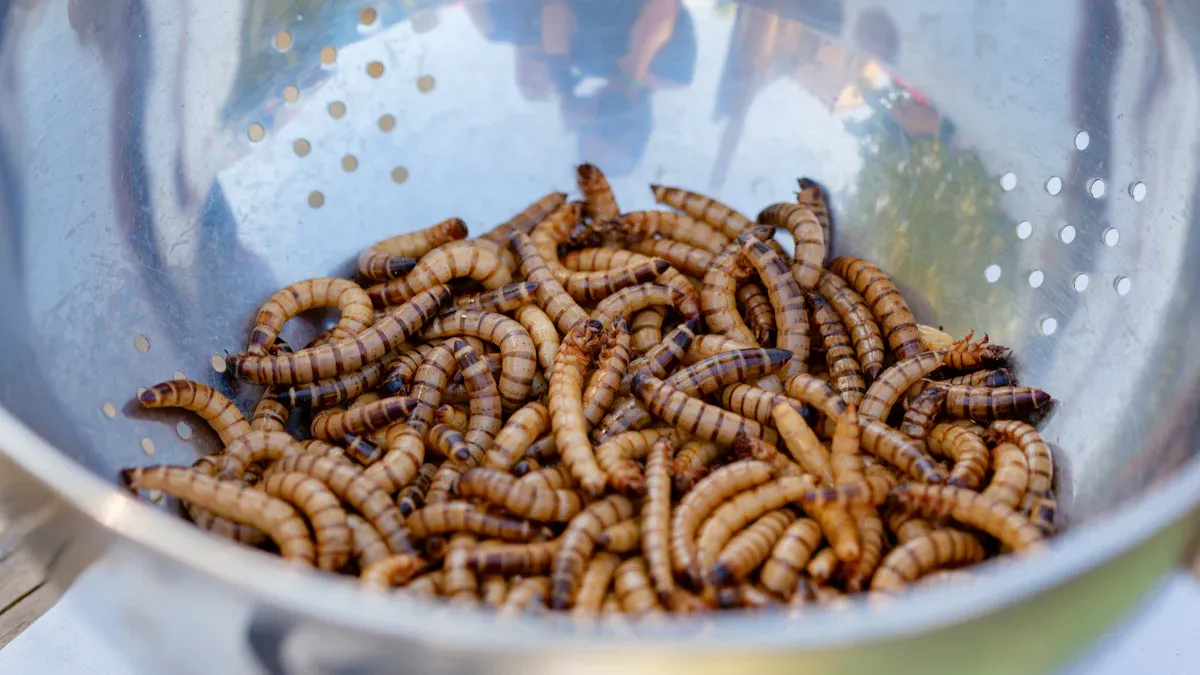
Feeding birds can be both rewarding and simple when you choose the right food. Microwave Dried Super Worm Bird Food offers a nutritious, protein-packed option that birds love. It’s easy to store and perfect for attracting a variety of species. Plus, it helps keep birds healthy and energized all year round.
Key Takeaways
- Microwave dried superworms are healthy bird food full of protein. They give birds energy and keep them strong, especially in winter.
- Try different ways to feed, like spreading superworms on the ground or using flat feeders. This can bring many types of birds to your yard.
- Soaking superworms in warm water before feeding makes them tastier for birds. This easy step can bring more birds, especially during nesting time.
Nutritional Benefits of Microwave Dried Super Worm Bird Food
High Protein and Energy Content
Birds need protein and energy to thrive, and that’s where microwave dried superworms shine. These little powerhouses are packed with protein, making them an excellent choice for birds that need a boost, especially during colder months or migration. You’ll notice how active and energetic your feathered visitors become when you add this food to their diet. The high energy content also helps birds maintain their body heat and stay strong, even in challenging weather.
If you’re wondering why protein is so important, think of it as the building block for feathers, muscles, and overall health. By offering Microwave Dried Super Worm Bird Food, you’re giving birds the fuel they need to stay healthy and vibrant.
Rich in Essential Nutrients
Microwave dried superworms aren’t just about protein. They’re also loaded with essential nutrients like calcium, phosphorus, and healthy fats. These nutrients play a big role in supporting bone strength, egg production, and even feather quality. Birds that eat a nutrient-rich diet are more likely to thrive, and you’ll see the difference in their appearance and behavior.
Want to attract a variety of species? This bird food appeals to insect-eating birds that crave a balanced diet. It’s a win-win for you and your backyard visitors.
Long Shelf Life and Easy Storage
One of the best things about Microwave Dried Super Worm Bird Food is how easy it is to store. Unlike live worms, these dried ones don’t require refrigeration or special care. You can keep them in a cool, dry place, and they’ll stay fresh for months.
This long shelf life means you can stock up without worrying about spoilage. Plus, the convenience of dried superworms makes feeding birds hassle-free. Whether you’re a seasoned bird enthusiast or just starting out, this food is a practical and reliable choice.
How to Feed Microwave-Dried Superworms to Birds
Methods of Presentation
How you present food to birds can make a big difference. With microwave-dried superworms, you have several options. You can scatter them on the ground to mimic natural foraging. Birds like robins and thrushes love this method. If you prefer a cleaner setup, try placing the superworms in a shallow dish or tray feeder. This keeps the food contained and makes it easier for birds to spot.
Another great option is using a platform feeder. It provides plenty of space for multiple birds to feed at once. Hanging feeders with small trays also work well, especially for smaller birds like chickadees or wrens. Experiment with these methods to see what works best in your yard.
Soaking Superworms for Better Appeal
Dried superworms are convenient, but soaking them can make them even more appealing. Birds often prefer softer food that resembles live insects. To soak them, place the superworms in a bowl of warm water for about 10-15 minutes. This rehydrates them and makes them plumper.
Once soaked, drain the water and offer the worms to your feathered friends. You’ll notice more birds flocking to your feeders when you do this. It’s a simple step that can make a big difference, especially during breeding season when birds need extra moisture.
Mixing Superworms with Other Bird Foods
Want to attract a variety of birds? Try mixing microwave-dried superworms with other bird foods. Combine them with seeds, suet, or fruit pieces to create a balanced meal. This mix appeals to both insect-eating and seed-eating birds.
For example, sprinkle some superworms into a seed blend or press them into suet cakes. You can also mix them with chopped apples or berries for a treat. This approach not only diversifies the diet but also encourages more species to visit your feeders.
Birds That Enjoy Microwave Dried Super Worm Bird Food

Common Backyard Birds
You’ll be surprised how many of your backyard visitors enjoy Microwave Dried Super Worm Bird Food. Birds like bluebirds, cardinals, and sparrows find these worms irresistible. They’re especially appealing to insect-eating species that naturally forage for protein-rich meals. If you’ve got a bird feeder set up, you’ll likely see these birds flocking to it in no time.
Want to make your yard even more inviting? Place the superworms in a shallow dish or scatter them on the ground. This mimics their natural feeding habits and encourages more birds to stop by. Watching these feathered friends enjoy their meal is a treat for any bird lover.
Migratory and Seasonal Visitors
During migration, birds need extra energy to fuel their long journeys. Microwave Dried Super Worm Bird Food is perfect for these seasonal visitors. Warblers, orioles, and even some woodpeckers may stop by your yard for a quick snack. Offering this high-protein food can make a big difference in their journey.
In spring and fall, keep an eye out for these travelers. They might only stay for a short time, but your feeders can provide the nourishment they need to keep going. It’s a great way to support bird populations during their most challenging times.
Birds Needing High-Protein Diets
Some birds require more protein than others, especially during breeding or molting seasons. Species like robins, wrens, and chickadees benefit greatly from the nutrients in superworms. These birds rely on protein to grow strong feathers and care for their young.
By offering Microwave Dried Super Worm Bird Food, you’re giving them the boost they need to thrive. It’s an easy way to support their health and ensure they keep coming back to your yard. You’ll feel good knowing you’re helping them stay strong and healthy.
Seasonal Feeding Tips for Microwave-Dried Superworms
Feeding in Cold Weather
Winter can be tough for birds. Food sources like insects and seeds become scarce, and birds need extra energy to stay warm. You can help by offering Microwave Dried Super Worm Bird Food. Its high protein and fat content provide the fuel birds need to maintain their body heat.
Place the superworms in a platform feeder or scatter them on the ground where birds naturally forage. If snow covers the ground, use a covered feeder to keep the food dry. You’ll notice birds like chickadees and juncos flocking to your yard for this nutritious treat.
Tipp: Feed birds early in the morning during winter. They need energy to start their day and survive the cold nights.
Supporting Birds During Breeding Season
Spring is a busy time for birds. They’re building nests, laying eggs, and raising chicks. This season demands a lot of energy and nutrients. Superworms are perfect for supporting their needs.
Soak the dried worms in warm water to make them softer and more appealing. Place them in a shallow dish near nesting areas. Birds like robins and bluebirds will appreciate the easy access to protein-rich food for their growing families.
Adjusting Feeding in Warmer Months
In summer, birds rely more on natural food sources like insects and fruits. However, you can still offer superworms as a supplement. Mix them with fresh fruit pieces or seeds to create a balanced snack.
Keep feeders in shaded areas to prevent the food from spoiling. Reduce the amount you offer if you notice less activity at your feeders. Birds will still visit, but they may not need as much help finding food during this season.
Comparing Microwave-Dried Superworms to Other Bird Food Options
Superworms vs. Mealworms
You might wonder how microwave-dried superworms stack up against mealworms. Both are popular bird food options, but they have some key differences. Superworms are larger and contain more protein and fat, making them a better choice for birds needing extra energy. Mealworms, on the other hand, are smaller and easier for tiny birds to eat.
If you’re feeding larger species like bluebirds or robins, superworms are the way to go. They provide a more satisfying meal and help birds stay energized during colder months or migration. For smaller birds, mealworms might be a better fit.
Tipp: Try offering both types to see which your backyard visitors prefer. Birds have their own tastes, just like us!
Superworms vs. Calciworms
Calciworms are another option you might consider. These worms are rich in calcium, which is great for birds during breeding season. However, they don’t offer the same protein and fat levels as microwave-dried superworms. If your goal is to support feather growth and overall energy, superworms win this round.
Calciworms can still be useful as a supplement. Mixing them with superworms creates a balanced diet that supports both bone health and energy needs. This combo works especially well for nesting birds.
When to Choose Superworms
Microwave Dried Super Worm Bird Food shines in situations where birds need a high-protein diet. Winter, migration, and breeding season are prime times to offer them. Their larger size and nutrient content make them ideal for medium to large birds.
If you’re looking for a versatile, easy-to-store option that appeals to a wide range of species, superworms are hard to beat. They’re perfect for attracting insect-eating birds and keeping them healthy year-round.
Microwave-dried superworms are a fantastic choice for feeding birds. They’re packed with nutrients, easy to store, and loved by many species.
Tipp: Try different feeding methods and adjust based on the season. Birds’ needs change, and experimenting helps you find what works best.
Store them properly in a cool, dry place to keep them fresh. Your feathered friends will thank you! 🐦
FAQ
How do I store microwave-dried superworms properly?
Keep them in a cool, dry place. Use an airtight container to prevent moisture. Proper storage ensures they stay fresh and nutritious for months.
Tipp: Avoid storing them near direct sunlight or heat sources to maintain quality.
Can I feed microwave-dried superworms to baby birds?
Yes, but soak them first. Rehydrating makes them softer and easier for baby birds to eat. Always monitor to ensure they’re eating safely.
How often should I offer superworms to birds?
Offer them a few times a week as a supplement. Birds enjoy variety, so mix superworms with seeds or fruits for a balanced diet.
Note: Adjust feeding frequency based on the season and bird activity in your yard.


